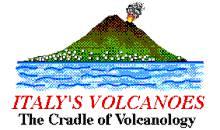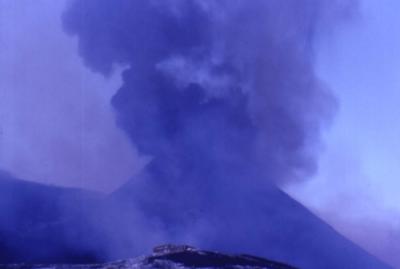|
WARNING:
Access to the summit area is DANGEROUS.
Eruptive activity at the summit craters is again increasing,
and sudden explosions that may drop pyroclastics (blocks and
bombs) are possible, especially at the SE Crater which has resumed
its episodic eruptive behavior. Besides this, weather conditions
are often unstable. The winter brings frequent snow storms and
clouds, and one gets easily lost due to the lack of points of
reference once there is a thick snow cover. One man was killed
in December 1999 when he fell into a chasm and dozens of people
have since then been reported lost and searched for, fortunately
without further tragic accidents. Excursions should be made
only with the mountain guides who can be contacted at the cable
car (near the Rifugio Sapienza) on the southern side of Etna,
or at the hotel "Le Betulle" at Piano Provenzana,
on the northern side.
|
12
February 2000 update.
The series of paroxysmal eruptive episodes from the SE Crater continues,
repeating the same phenomenon over and over again with only minor
modifications from one event to another.
The chronology of eruptive episodes initiated on has been extended
by three more paroxysmal episodes since the last update, one at about
0530 h (local time=GMT+1) on 11 February, the second at about 2200
h on the same day, and the most recent so far at about 1000 h on 12
February. Like their predecessors they were short-lived but very spectacular,
and especially the on at 2200 on 11 February was observed by hundreds
of thousands of people in eastern Sicily. This event was also observed
with telescope, filmed and photographed by Boris Behncke (Dipartimento
di Scienze Geologiche of Catania University) and Giuseppe Scarpinati
(Italian correspondent of "L'Association Volcanologique Européenne",
L.A.V.E.) from Scarpinati's home in Acireale, allowing a good documentation
of the episode in all its stages.
For hours before the onset of increased activity, trickles of lava
were emitted from the vent on the N flank of the SE Crater cone, feeding
small flows that advanced no more than 100 m. After 2130 h, the effusive
activity at this site became more vigorous, and a more substantial,
longer flow formed. At about 2145 h, spattering was observed at the
effusive vent, and from then on small fountains began to play from
vents that opened one after the other towards the summit of the cone
- that is, an eruptive fissure propagated upslope, a phenomenon that
had already been observed by Scarpinati on the late evening of 6 February.
The lowermost of these vents produced a jet of very fluid lava inclined
strongly towards N or NE. Shortly before 2200 h Strombolian bursts
became visible at the summit of the SE Crater cone, which rapidly
increased in strength and frequency, and eventually became a continuous
jet of fluid magma. The fountain height increased in the course of
a few minutes from about 50 m to more than 250 m, and more fountains
appeared on the upper S and N flanks, so that by 2205 h there were
four huge fountains rising from the fractured upper part of the cone,
producing a fan-shaped wall of fire. Two vents were located immediately
to the N of the summit vent, while another one lay to the S; this
latter one fed a voluminous flow to the S, in the direction of Torre
del Filosofo.
For about 10 minutes the activity continued at full scale, with four
main fountains in the summit area, and a row of smaller fountains
playing from the fissure on the N flank. Lava was emitted in large
volumes from that fissure, feeding a bilobate flow into the Valle
del Bove.
The summit vent was the first to cease, at about 2215 h, although
for a few minutes there were intermittent jets of lava, and the other
three main vents ceased shortly thereafter. For a few minutes, small
fountains still played at the vent at the downslope end of the northern
fracture, but by 2220 h all activity was limited to lava flowing from
the northern fissure, while feeding of the southern flow had stopped.
Spectacular footage of the event was shown today in Italian news services,
providing an excellent documentation of the culminating phase of the
paroxysm.
The paroxysm which occurred at around 1000 h on 12 February produced
a spectacular black tephra column and fountains from the summit vent
and probably also from the N flank of the SE Crater cone. In contrast
to the preceding eruptive episodes, little activity appears to have
occurred on the upper S flank, but after the cessation of the paroxysmal
activity, dense ash emissions continued from a vent on the upper N
flank for about 30 minutes.
10
February 2000 update.
Eruptive episodes are now occurring at the SE Crater at a rhythm of
approximately 12 hours. The crater produced two new episodes at around
midnight (9/10 February) and at about noon on 10 February. Visibility
is seriously hampered
by clouds, as the weather conditions have become more unstable, but
bright incandescence was seen at the summit sometime around midnight
last night, and a large plume was seen rising above weather clouds
at about noon today from Catania. Brief glimpses of the summit area
this morning revealed that most of the summit cone complex - except
the SE Crater cone - was covered with fresh snow; following the noon
paroxysm, the main summit cone was blanketed with black tephra.
Reviewing the ongoing series of paroxysmal eruptive episodes from
the SE Crater, the following is to be stated:
Since 26 January, sixteen eruptive episodes have occurred. #1: 26
January; #2: 29 January; #3: 1 February; #4: 2 February; #5: 3 February;
#6 and #7: 4 February; #8: 5 February; #9 and #10: 6 February; #11:
7 February; #12 and #13: 8 February; #14 and #15: 9 February; #16:
10 February. Repose intervals ranged from 8 hours (between episodes
#12 and #13) to 3 days (between episodes #1 and #2, and between episodes
#2 and #3). There is no clear regularity in the interval between these
episodes, although some clusters (up to three consecutive episodes)
are separated by regular intervals. Lava apparently flows from vents
at the lower NNE or NE flank of the SE Crater cone more or less continuously,
and the effusion rate increases notably just before the onset of a
paroxysmal episode. While many of the earlier episodes culminated
in the fracturing of the SE Crater cone, some of the latter do not
appear to have involved fracturing, and most, if not all, lava was
delivered from the summit vents and possibly one or more vents located
immediately below the summit vent on the S and N flanks.
The outcome of this new, vigorous phase of eruptive activity is uncertain.
So far the activity has been limited to the SE Crater and its immediate
vicinity, and the activity may continue this way for some time to
come. However, the SE Crater sits at the intersection of two of the
main fracture systems extending under the flanks of Etna, which have
produced most of the flank eruptions of the interval 1971-1993, and
many of these eruptions were preceded or accompanied during their
initial stages by activity at the SE Crater. It is thus a question
of time how long these fracture systems, which are clearly very closely
related to the SE Crater, will remain stable. Etna is producing summit
eruptions since the summer of 1995, and seven years have passed since
the end of the last flank eruption, an unusually long period without
such activity.
| 8
February 2000 photos |
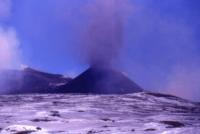 |
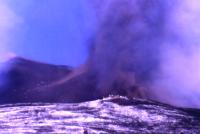 |
Beginning
of eruptive episode at the SE Crater at about 1130 h on
8 February, seen from northern flank of the Montagnola.
The activity at this time consists of discrete Strombolian
explosions
|
|
| The
activity at the SE Crater intensifies rapidly; about 10
minutes after the first photo was taken large bombs fell
onto the flank of the SE Crater cone, raising dense plumes
of dust |
|
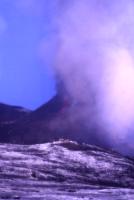 |
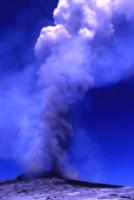 |
Increasing
activity at the SE Crater and lava emission onto the S flank
of its cone (showing dull red in the photo), at about 1140
h on 8 February. Torre del Filosofo lies in front of the
cone
|
|
The
paroxysm at the SE Crater has reached its climactic phase,
and a dense eruption colum rises about 2 km above the crater,
densely charged with ash in its lower part
|
|
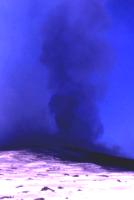 |
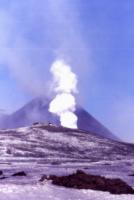 |
| Fifteen
minutes after the start of the most intense phase of the
paroxysm, the activity begins to wane rapidly, and dense
ash puffs are ejected from the SE Crater, casting a shadow
over the area to the S of its cone |
|
| The
paroxysm is over, but lava continues to advance near the
base of the SE Crater cone. White vapor is generated as
the flow front interacts with a snow field lying on the
S side of the cone |
|
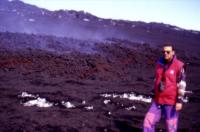 |
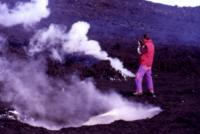 |
| At
about 1300 h, lava continues to flow near the SE base of
the SE Crater cone, but flow movement is slowing. Person
at right is Giuseppe Scarpinati |
|
| Scarpinati
photographing plumes of vapor generated as hot lava encounters
snow. The snow, with a thickness of 1.5-2 m lies under a
layer of black tephra |
|
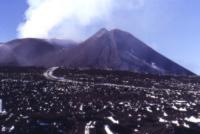 |
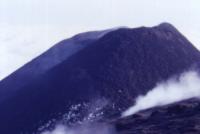 |
| The
cone of the SE Crater seen from south a few hours after
the paroxysm. Lava flow channels are clearly visible on
the cone's flanks, highlighted by the light of the low-standing
sun. The large gas plume at left is rising from the Bocca
Nuova |
|
| Summit
of the SE Crater cone seen from the southeastern side of
the Voragine, at about 1530 h on 8 February. The N rim of
the crater is breached; active lava flows from the lower
end of the breach (outside the photo to the left) |
|
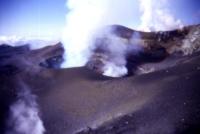 |
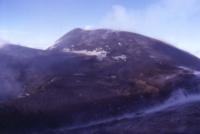 |
| A
view of the Bocca Nuova from its southern rim, showing the
eastern-central double crater on its floor, from which hot
gas was emitted forcefully every few minutes |
|
| Eastern
part of the Voragine (with the 4 September 1999 pit at extreme
left), and the NE Crater in the background. Photo was taken
from the southeastern rim of the Voragine |
|
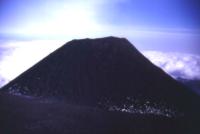 |
| The
northwestern face of the SE Crater cone seen from the SE
side of the main summit cone. The height of the summit of
the cone is almost equal to the height of the former Central
Crater rim, from which this photo was taken |
|
9
February 2000 update.
Twelve hours after its previous paroxysmal eruptive episode, the SE
Crater produced another such event sometime between 0800 and 0900
h (local
time=GMT+1) on 9 February. Like its predecessors this episode was
of short duration and generated lava fountains, flows, and an eruption
column mainly composed of vapor. Twelve hours after this event, no
renewed eruptive activity has yet occurred, but more paroxysmal episodes
are to be expected in the next few days.
8
February 2000 update.
Eruptive episodes continue to occur from the SE Crater at an amazing
pace. Today (8 February) there were two more such epsiodes, one at
about 1130 h (local
time=GMT+1) and the other shortly after 2000 h - after a quiet interval
of only 8 hours. The first of these episodes was witnessed at close
range by Boris Behncke (Dipartimento di Scienze Geologiche of Catania
University) and Giuseppe Scarpinati (Italian correspondent of "L'Association
Volcanologique Européenne", L.A.V.E.). At about 1105 h
a white plume had appeared at the summit of the SE Crater cone, and
dense gas clouds rose from a lava flow on the rear side of the cone,
flowing east- or northeastwards. In the past week such phenomena had
always marked the buildup phase preceding paroxysmal eruptive episodes,
and so it was again today. The activity rapidly increased, first with
discrete Strombolian bursts, which after a few minutes blended into
a continous uprush of magma. Much of the SE Crater cone was rapidly
veiled by a dense curtain of falling ash, but large bombs were seen
flying parabolically from both sides of the ash curtain and impacting
on the upper slopes of the cone.
The activity generated a continuous loud roaring noise, punctuated
by even louder detonations, and an impressive eruption column - mainly
water vapor, but with a significant amount of ash in its lower part
- rose to several kilometers above the erupting cone. Brief clearings
in the ash curtain permitted views of lava flowing down the southern
flank of the cone, and sometime later dense brown plumes indicated
that the fracture on the S flank had possibly reopened, or that part
of the flowing lava transformed into avalanches on the steep flank
of the cone.
The culminating phase of the activity lasted precisely 15 minutes,
after that it waned rapidly, but isolated explosions and frequent
ash emissions continued for another 30 minutes. Meanwhile the lava
flowing at the southern base of the cone encountered a snow field,
and a white vapor plume was generated.
When Behncke and Scarpinati arrived near the base of the cone, lava
was still slowly advancing on top of the scoria-covered snow, but
all eruptive activity had ended. They climbed to the S rim of the
Bocca Nuova which gave intermittent loud roaring noises and fed a
dense gas plume. The activity was revealed to occur at a vent located
in the western part of the large crater seen during the previous visit
in the E part of the Bocca Nuova, and it consisted of vigorous gas
jetting, which at times intensified to produce an incandescent gas
column about 50 m high, accompanied by loud, jet-plane-like noises.
None of these emissions was accompanied by pyroclastic ejections.
Behncke briefly visited the Voragine, which was found in a very quiescent
state, with only weak vapor emission from the large pit crater formed
during the 4 September 1999 eruption. From the eastern side of the
Voragine, Behncke obtained a perfect view of the northern side of
the SE Crater cone. The northern crater rim was breached, and a fracture
extended from there about half way down the cone to end at a knob
of lava from which small tongues of actively flowing lava - this was
the vent area for the lava which has been seen flowing constantly
in the past days, even between paroxysms at the SE Crater.
When leaving the summit area at sunset (about 1730 h), Behncke and
Scarpinati observed that slow lava extrusion had resumed from a vent
high on the S flank of the SE Crater cone, and incandescent blocks
frequently detached from a lava front advancing slowly downslope.
This was the initiation of the buildup for another paroxysm which
occurred shortly after 2000 h. It was essentially identical to its
predecessors, but the S flank does not appear to have fractured, instead
a lava flow was fed directly from the summit vent.
| 7
February 2000 photos |
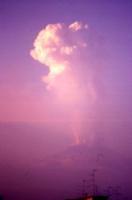 |
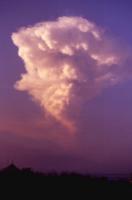 |
Eruption
column rising from the SE Crater shortly after 1700 h on
7 February. This view was obtained during hazy weather conditions
from the top of the Palazzo delle Scienze in Catania
|
|
Fully
developed, mushroom-shaped plume of the eruptive episode
at the SE Crater on the late afternoon of 7 February, seen
here from Villa Bellini in Catania at about 1720 h
|
|
7
February 2000 update.
Another, spectacular eruptive episode occurred at about 1700 h (local
time=GMT+1) on 7
February at the SE Crater. It produced brightly incandescent lava
fountains, lava flows, and a large eruption column mainly composed
of white vapor, which rose several kilometers above the summit and
was well visible from most of eastern Sicily. The previous eruptive
episode occurred between 2300 and 2330 h
on 6 February, 19 hours after the previous paroxysm. The buildup to
this event was strictly identical to its predecessors, with gradually
increasing lava effusion on the northern or northeastern side of the
SE Crater cone, and mild Strombolian activity from a vent high on
the SSW flank of the cone. At the height of the activity, lava fountains
jetted from the summit vent of the SE Crater cone, and a broad lava
flow moved down the SSW flank, overriding the flows of earlier episodes.
At midnight the activity was waning, although lava still moved down
the SSW and NE (?) flanks.
The most significant effect of the frequent paroxysmal eruptions from
the SE Crater (at least nine such events have occurred since 26 January)
is the growth of its cone - it is probably higher now than ever before,
and if growth continues, the crater might become the highest point
on Etna. It is still about 30-40 m lower than the present summit of
the volcano, but the current growth rate is several meters per week.
A
series of other web pages covering the October-November eruptions
of the Bocca Nuova have recently been posted; these contain photos
and movie clips of some of the most spectacular moments of that period.
A
photo gallery covering the period September-November 1999 (with photos
by Boris Behncke and Giuseppe Scarpinati)
Photos
of the eruptive activity, 26-31 October 1999, by Tom Pfeiffer (University
of Arhus, Denmark)
Photos
by Marco Fulle, 17-23 October 1999, at Stromboli On-line - Marco at
his best
Very
impressive video clips, taken by Roberto Carniel on 17-23 October
1999, at Stromboli On-line
Photos
by Juerg Alean, of 1 November 1999, at Stromboli On-line
Video
clips, taken by Juerg Alean on 1 November 1999, at Stromboli On-line
A
page by Charles Rivière, France, with many photos of the summer
and autumn of 1999 (in French)

visitors counted since 12 February 1999
(This page has received an incredible 4362
hits during the week of 24-30 October! - And, amazingly
enough, 4430 hits were counted
the week after.)
FastCounter
by LinkExchange
Page set up on 27 May 1997, last modified
on 12 February 2000
